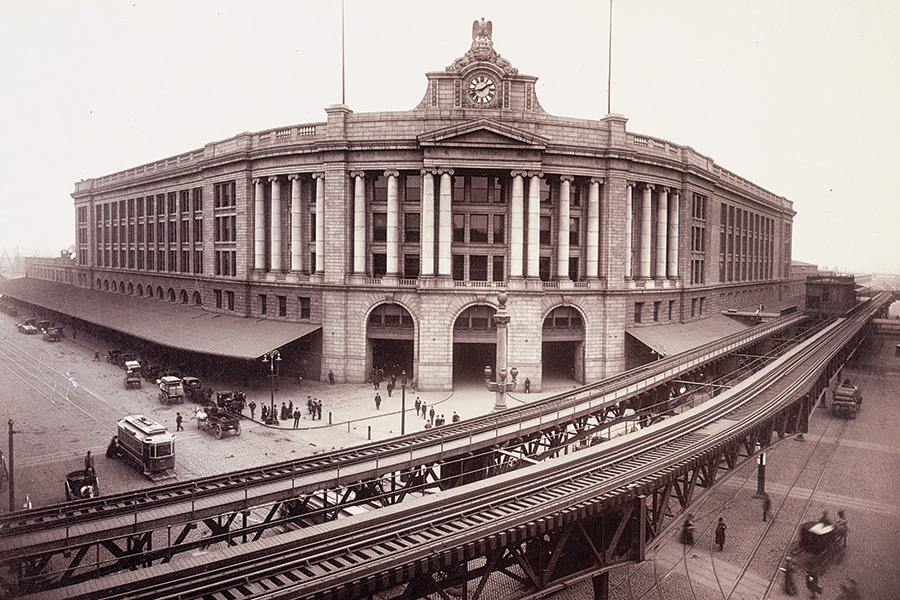The History Behind South Station, New England’s Largest Train Depot
Take a trip through the structure's surprising past.

South Station circa 1902, when carriages were allowed to pass through the arched entrance. / Photo courtesy of Historic New England, archival photograph by Nathaniel L. Stebbins
South Station is New England’s largest train station, but today’s riders may not realize that it used to be much bigger. In fact, when its first train departed at 4:38 a.m. on January 1, 1899, bound for Newport and lugging 12 tons of Boston newspapers, the headlines billed it as the biggest station in the world.
Work had started in 1896, when five railroads—Boston and Albany, Boston and Providence, Old Colony, New England, and New Haven—teamed up to build a union station for trains chugging into the city from the south and the west. Forming the Boston Terminal Company, they hired the firm of Shepley, Rutan and Coolidge, protégés of famed architect Henry Hobson Richardson, who designed Copley Square’s Trinity Church. But for this project, they didn’t hew to his namesake Richardsonian Romanesque style. Instead, they drew inspiration from the Neoclassical Revival style favored by the City Beautiful movement of the 1890s, which aimed to bring grandeur to urban architecture.
The end result was grand indeed: a stately five-story headhouse of pink granite and tan brick, flanked by two brick wings that stretched down Atlantic Avenue and Summer Street, plus a massive metal shed that sheltered 28 tracks. “This great terminal station, laid out upon such a comprehensive scale, so liberal in its accommodations and so complete in all its equipment, will hereafter rank as one of the great public buildings of this city,” Mayor Josiah Quincy III told the crowds gathered for the dedication. They oohed and ahhed as 1,200 electric lights turned on at once, illuminating a vast waiting room with coffered ceilings, arched windows, and marble mosaic floors. Outside, the headhouse’s curved façade had been lined with Ionic columns and topped by an ornate clock with a 12-foot face. Built by Roxbury’s Edward Howard Clock Company and modeled after Big Ben, it provides a perch for an 8-ton granite eagle and is still wound by hand.

Salt air eventually corroded the train shed, which was demolished in 1930. / Photo courtesy of Boston Public Library, Leslie Jones collection
The station’s amenities were impressive, too. Staffed by white-aproned attendants, a nursery by the ladies’ lavatories was equipped with cradles and rocking chairs. The gents, meanwhile, had a smoking lounge, a shoeshine emporium, and a barbershop. Kiosks sold sundries and snacks, but travelers looking for heartier fare could claim one of 200 stools at marble-and-mahogany lunch counters. In 1931, a former carriage concourse became the home of a 600-seat movie theater. It screened newsreels, cartoons, and short films until the mid 1950s, when the theater was transformed into a chapel. Dubbed Our Lady of the Railways, it offered 18 masses on Sundays—with speedy sermons for worshippers with a train to catch. There was even an employee bowling alley, located in a subterranean “ghost terminal” intended for an electric rail project that never materialized.
For years, South Station was the country’s busiest terminal; it served 38 million passengers in 1913, when Grand Central Terminal saw a mere 22 million. But the rise of highways and airlines ended the golden age of rail travel. As ridership declined, South Station deteriorated, and the Boston Redevelopment Authority (now known as the Boston Planning & Development Agency) bought the property in 1965. Hoping to redevelop the site, the BRA removed tracks and demolished the wings; the wrecking ball might have claimed the entire headhouse, but a campaign succeeded in adding Boston’s only remaining Neoclassical Revival structure of note to the National Register of Historic Places in 1975. Three years later, the BRA sold South Station to the MBTA, which embarked on major renovations in the ’80s and ’90s, restoring tracks, rebuilding with materials from the original quarry and brickmaker, and adding direct Red Line access and a bus terminal.

Today, visitors can explore the station via free walking tours. / Photo by Warren Patterson
Big changes may be coming once again. Houston developer Hines hopes to build a 51-story commercial and residential tower in the airspace over the tracks. And as Boston battles the country’s worst rush-hour traffic, officials are considering proposals to ease congestion by either expanding South Station or linking it with North Station—a move that would create an uninterrupted route from the nation’s capital all the way to Maine. One hundred twenty years after its debut, the storied station is still making headlines.


